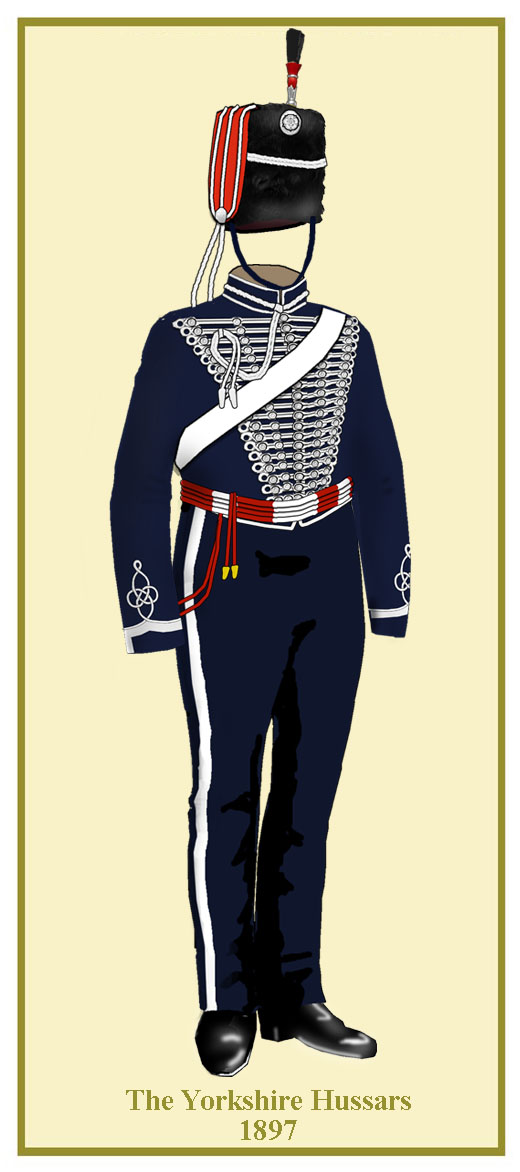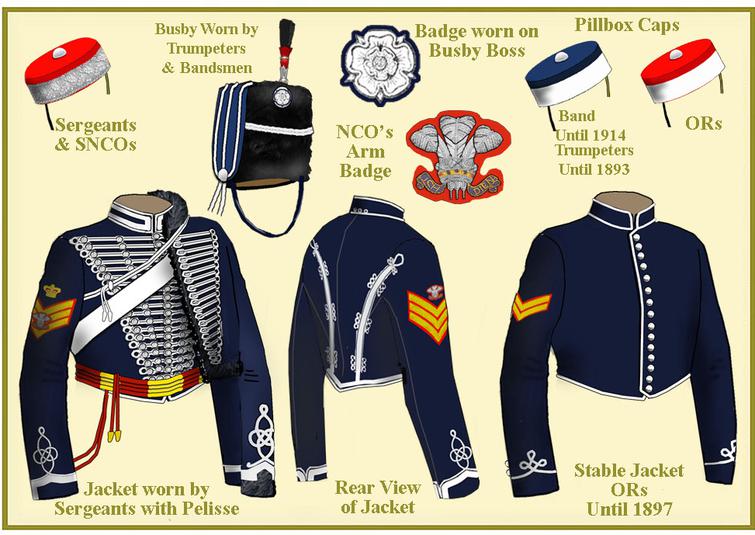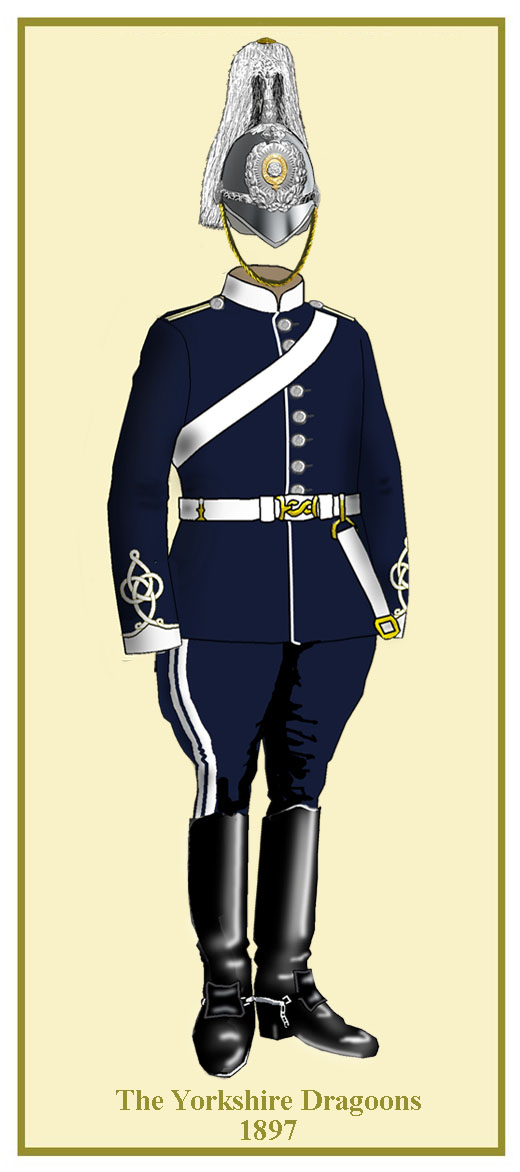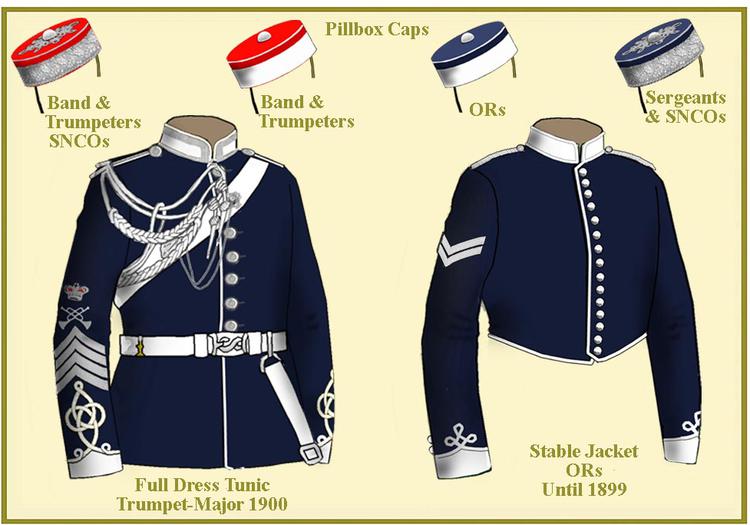The Yorkshire Hussars (Princess of Wales's Own)
Ranked No. 3 in Yeomanry Order of preference
Raised as the Yorkshire West Riding Yeomanry in 1794 consisting of the 1st (Southern Regt) and the 2nd (Northern Regt) the former with 9 troops and the latter with 6. After disbandment in 1802 seven troops (later nine) reorganized as the “Northern Regiment of West Riding Yeomanry” within a matter of weeks. In 1819 the regiment adopted the title “The Yorkshire Hussar Regiment of Yeomanry Cavalry”. The additional title of “Princess of Wales’s Own” was conferred in 1864.
Formed 9th Coy and (Part) 66th Coy of the 3rd Bn Imperial Yeomanry in 1900
UNIFORMS OF THE BRITISH YEOMANRY REGIMENTS 1895-1900
PART 10
Uniforms
The first uniform for both Yorkshire corps (see Yorkshire Dragoons below) was a scarlet coat with green collar and cuffs, buff waistcoat and breeches with a black felt round hat with bearskin crest and green over white plume on the left. By 1800 this uniform had changed to a scarlet light dragoon jacket with white/silver frogging, wings and buff breeches. The facings remained green and the round hat was changed for a Tarleton helmet with green turban and red over white plume. The Northern regiment when re-raised in 1802 were again dressed in scarlet light dragoon jackets with silver lace but this time with yellow facings and a Tarleton Helmet with blue turban and white over red plume. Trumpeters and farriers wore scarlet peaked shakos with an Austrian style bearskin crest worn athwart, trumpeters with a large white metal decorated plate on the front along with white jackets while the farriers had a white metal horseshoe instead of the plate on the bearskin shako and the jacket was blue. Blue overalls with double yellow stripes were worn over the breeches from 1805. In 1817 black shakos replaced the Tarleton helmets with band and trumpeters wearing scarlet shakos. On becoming hussars in 1819 the regiment was issued with red pelisses with black fur and trumpeters, the band and farriers exchanged their jackets for scarlet ones similar to the men which for all ranks were changed to blue without facings (along with the pelisses) in 1828. Overalls became grey. Scarlet shakos were taken into wear in 1840 and the band and trumpeters adopted garter blue ones, all with black drooping plumes. In the year 1856 black busbies with scarlet bags were introduced. From this time, the uniforms changed very little until 1914.
By 1881 other ranks were wearing the 1850 pattern hussar jacket braided in a similar manner to officers except in white instead of silver. The cuffs had a plain white Austrian knot above a ½ Inch wide lace band terminating at the lower part of the rear of the cuff. There were no shoulder cords and the rear of the jacket was again similar to officer’s pattern except that the collar had three small eyes on the lower edge and there were no “dummies” at the waist. A white and crimson barreled sash was worn with blue breeches or overalls with a single white stripe. The hussar busby was the 1857 style with scarlet bag and white cords and a black over red plume along with a black leather chinstrap instead of chains.. Although the 1887 pattern busby was ordered in the late nineties, few seem to have been distributed by 1900. Pantaloons and knee boots were being worn by 1895. Sergeant-Majors and QMs had silver laced jackets and silver busby cords, while sergeants had silver laced jackets and white busby cords, both had an extra silver lace edging on the collar. Sergeant majors wore gold and crimson barreled sashes while sergeants wore yellow and crimson ones. Rank badges and Chevrons were gold bias lace on a scarlet ground and NCOs above corporals wore the Prince of Wales’s feathers badge on or above the chevrons. (It is uncertain when the badge moved from above to on the chevrons. The band and trumpeters wore then same uniform as the men except that the busby bags were garter blue. Trumpeters’ bags changed to scarlet in 1893. A particular distinction of the regiment was the wearing of pelisses by other ranks. A number of these were retained for special escort occasions only right up until 1914. They were probably the last formation of the British army where other ranks wore pelisses.
In undress other ranks wore a blue stable jacket with no facings but white tracing cord on the collar, down the front and bottom and above the cuffs terminating in a trefoil. Senior NCOs wore silver cord. Plain blue five button frocks were issued by 1900. A plain scarlet pillbox cap with white band and button was worn (Silver, like officers for sergeants and above). The band wore garter blue pillboxes. Folding field caps were not issued to the men until after 1900.
Full dress was retained for special parades right up until 1914. After 1902 other ranks lost their barreled sashes although sergeants an above continued to wear them. The pillbox cap was also worn until 1914 for most full dress parades and walking out although the 1911 coronation detachment wore busbies and full dress.
After the Boer War a plain khaki uniform was issued for field wear the only distinction being red piping on the outside seams of the breeches. A slouch hat was worn with turn-up on the left side and a white over red plume. Brown leather leggings were worn. The blue frock and overalls were often worn for other duties. In 1907 the regular khaki British army khaki uniform was issued along with a scarlet peaked staff pattern cap.
The Yorkshire Dragoons
Ranked No. 9 in Yeomanry Order of preference
Raised alongside the Northern Regiment as the Southern Regiment in 1794, it did not re-form for a year after disbandment at the Peace of Amiens. It formally became the “Southern Regiment of West York Yeomanry” in 1821. Along with its sister regiment, it dealt with the Chartist riots in the 1840s. It assumed the title of “1st West York Yeomanry Cavalry in 1844. Its title was changed to Dragoons in 1889 and the further title of “Queen’s Own” was bestowed on them by her Majesty after a visit to Sheffield in 1897.
Formed 11th Coy and (Part) 66th Coy of the 3rd Bn Imperial Yeomanry in 1900
Uniforms
The scarlet faced green uniforms of 1794-1802 have been described above. It is thought that the Southern corps changed from scarlet to blue before 1799 albeit still with green facings. Upon re-raising in 1803 the jackets were now plain, without facings and simply three rows of buttons down the front. Breeches were now white and the Tarleton helmet was now black or dark blue with a plain white feather. By 1816 the Tarleton helmet was still in use but the jacket (at least for officers) appears to have the laced front restored. By 1824 the regiment was wearing black felt (beaver for officers) shakos with white over red upright plumes. The jacket was now in Dark blue light dragoon fashion with silver/white laced front. Overalls were close to sky blue with double scarlet stripes. In 1835/6 the shako plumes were replaced with black drooping horsehair. By 1844 the shako had changed to a shorter slightly bell topped version but the jacket remained the same except for some minor modifications. Following the Crimean War, the regiment’s uniforms appeared very outdated and as a stop gap measure stable jackets were worn in all orders of dress from 1860. Finally in 1862 a completely new uniform was adopted. First was an unusual bearskin cap, somewhat similar to the Royal Scots Greys but more like that of the Royal Artillery without the bag. A short white plume was worn on the left side emanating from a white-metal grenade ball decorated with the rose. This was followed by the contemporary Lancer tunic in dark blue with no facings, but piped all round and on the lapels in white with Austrian knots on the cuffs. Trousers were Oxford mixture with double scarlet stripes. A black leather belt was worn with snake clasp. In 1876 the bearskin cap was replaced by the 1847 Albert pattern helmet with white horsehair plume. By 1881 the uniform had smartened up considerably. A white and blue striped worsted girdle had replaced the black belt and dark blue overalls with double white stripes had replaced the old Oxford grey ones.
In 1889 the regiment finally took into wear the uniform it would retain until the end of full dress. Except for the details on the 1847 pattern Albert pattern helmet, it was identical to that of the North Somerset Yeomanry, which in turn mirrored the uniform of the 6th Dragoon Guards. Senior NCOs wore extra lace on the collars and Chevrons and badges were silver on a blue ground. Pantaloons and knee boots had been issued in 1886. The band and trumpeters wore the same helmet as the rest of the regiment but wore plaited aiguillettes on the right side of the tunic like the 6th Dragoon Guards. White gauntlets appeared in 1898.
In undress a blue stable jacket was worn with white collar and cuffs but edged all round in white cord with trefoils on the cuffs. Pill box caps were worn; blue for all ranks, scarlet for the band and trumpeters (from 1891) with white band and button for ORs and silver lace and top decoration for sergeants and above. In 1901 a blue five button frock was introduced which had shoulder chains and white pointed gorget patches on the collar. Also a folding field service cap was adopted with white body and blue flaps. As many of the men were fighting in South Africa at the time, these articles did not become universal issue until after their return.
After 1903 a khaki serge uniform was taken into wear with white piping on the seams of the breeches and trefoils on the cuffs. The slouch hat was uniquely turned up on the right side with a brown leather band and a brown tuft above a blue and white cockade on the left. The full dress now was one of the smartest in the Yeomanry. The blue serge tunic with white collar patches was worn with the white metal plumed helmet now modified with fluted plume holder. The dark blue overalls had double white stripes. This was the uniform worn at the coronation of 1911.
Yorkshire Hussars
Yorkshire Dragoons






